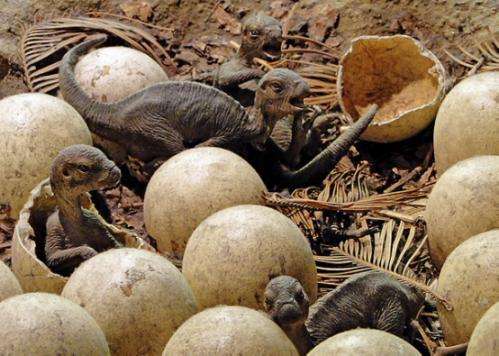A T-Rex of an idea: Dinosaur milk?

(Phys.org)—Did dinosaurs lactate? It's a question physiology expert Professor Paul Else has been pondering for years –15 years in fact.
But before you start imagining T-Rex in a bra, Professor Else said dinosaur lactation, if it did in fact exist, would have involved secretions from the upper digestive tract that produce a 'milk-like' substance.
"Pigeons, emperor penguins and flamingos all produce 'milk-like' substances from crop glands or glands of the oesophagus that they feed to their young through their mouths," he said.
"Since birds and dinosaurs share much in common I proposed that some dinosaurs likely used this feeding strategy."
Professor Else's theory has been published in the latest issue of The Journal of Experimental Biology.
In the article, he argues that the greatest potential advantage of dinosaur lactation is that the milk fed to the young can be 'spiked' with additives, such as antibodies, antioxidants and growth hormone.
"These are all examples of additives found in the milk of pigeons that allow their young to grow at phenomenal rates", Professor Else said, adding that his theory could help explain how dinosaurs grew so quickly.
While there is no hard evidence of lactation in the fossil record of dinosaurs as the process would involve examining soft tissues, which are not preserved as fossils, Professor Else points to a case study he proposed – the herbivorous duckbills (hadrosaurs).
"Hadrosaurs were herd, site breeders with nest bound young fed by parents. The proposal is that rather than regurgitating partially fermented plant matter these dinosaur parents initially used lactation then progressed to plant regurgitation."
So why did a researcher with an interest in membrane lipids write a paper on dinosaur lactation?
"Although I work at the molecular level I'm basically a comparative physiologist and one thing that always struck me as unresolved about dinosaurs was how a dinosaur parent of several tonnes could feed young of only a few kilograms. It seemed obvious, a form of lactation, similar to that present in birds.
"So I sat on the idea for about 15 years waiting to have some time to explore it. Finally, when on study leave, I sent 300 words describing the idea to the editor of the Journal of Experimental Biology. The editor liked it and asked for an article – and that's when the work really began – taking a pure idea and making it real, while at the same time being critical about the possibility of dinosaur lactation," Professor Else said.
What's next for Professor Else? "For the moment, it's back to membrane lipids and wait for the 'real' dinosaur scientist to get over this provocative idea that I've proposed".
More information: jeb.biologists.org/content/216/3/347.abstract
Journal information: Journal of Experimental Biology
Provided by University of Wollongong












.jpg)






